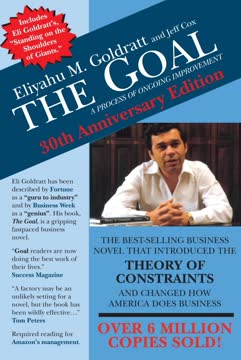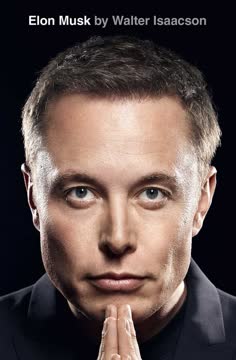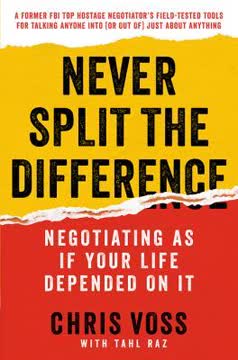Key Takeaways
1. Customer Obsession: The Foundation of Amazon's Success
"We don't make money when we sell things. We make money when we help customers make purchase decisions."
Relentless focus on customers. Amazon's first leadership principle is "Customer Obsession," which drives every decision and innovation. This means starting with the customer and working backward, constantly seeking ways to improve their experience. Amazon measures success not just by sales, but by how well they help customers make informed decisions.
Metrics that matter. To ensure customer-centricity, Amazon developed metrics like the Perfect Order Percentage (POP), which tracks orders that are perfectly accepted, processed, and fulfilled. They also use real-time data and instrumentation to continuously monitor and improve customer experiences.
Key customer-centric practices:
- Writing future press releases from the customer's perspective
- Developing detailed user manuals before building products
- Creating customer personas and journey maps
- Measuring and optimizing for customer trust
2. Embrace Failure and Experimentation for Innovation
"I believe we are the best place in the world to fail (we have plenty of practice!), and failure and invention are inseparable twins."
Culture of experimentation. Amazon encourages rapid experimentation and is willing to accept failures as part of the innovation process. They use a "launch and learn" strategy, starting small and scaling successful ideas.
Minimum Viable Products. The company often releases early versions of products to gather customer feedback and iterate quickly. Examples include the evolution from the Amazon Dash Wand to Dash Buttons and eventually to Alexa-enabled devices.
Keys to successful experimentation:
- Small, low-risk experiments
- Clear hypotheses and metrics
- Rapid iteration based on feedback
- Willingness to kill unsuccessful projects quickly
3. Think Long-Term and Make Bold Decisions
"We think about one-way doors and two-way doors. A one-way door is a place with a decision if you walk through, and if you don't like what you see on the other side, you can't get back."
Long-term orientation. Bezos famously uses a "regret minimization framework" for major decisions, projecting himself to age 80 and considering what he'd regret not trying. This long-term thinking allows Amazon to make bold investments that may not pay off for years.
Decision-making framework. Amazon categorizes decisions as either "one-way doors" (irreversible) or "two-way doors" (reversible). This helps them move quickly on reversible decisions while carefully considering irreversible ones.
Examples of long-term thinking:
- Investing in AWS despite initial skepticism
- Developing drone delivery technology
- Building a vast logistics network
- Acquiring Whole Foods to enter the grocery market
4. Build a Culture of High Standards and Accountability
"A team at Amazon's Las Vegas, Nevada, fulfillment center streamlined the customer returns process, improving productivity 34 percent, eliminating excess walking distance by 128,000 ft. per day, and reducing work in process by 46 percent."
Continuous improvement. Amazon fosters a culture where every process, customer experience, and function has an improvement plan and road map. They use techniques like Six Sigma and kaizen to drive operational excellence.
Accountability through metrics. The company uses detailed, real-time metrics to track performance and hold teams accountable. They conduct regular "metrics meetings" to review data, identify issues, and drive improvements.
Key practices for maintaining high standards:
- Bar Raiser program for hiring
- Writing detailed narratives instead of using PowerPoint
- Regular operational reviews focused on metrics
- Empowering employees to identify and solve problems
5. Leverage Technology and Data for Operational Excellence
"Any sufficiently advanced technology is indistinguishable from magic."
Tech-driven innovation. Amazon constantly leverages technology to improve operations and customer experiences. From machine learning algorithms to robotic fulfillment centers, they use cutting-edge tech to drive efficiency and innovation.
Data-driven decision making. The company collects and analyzes vast amounts of data to inform decisions and optimize operations. They use this data to personalize recommendations, optimize inventory, and improve logistics.
Examples of technology-driven improvements:
- Just Walk Out Technology in Amazon Go stores
- Kiva robots in fulfillment centers
- Machine learning for demand forecasting
- AWS for cloud computing and services
6. Empower Small, Autonomous Teams for Agility
"If you can launch x in y without a meeting or a new org structure, the speed of expansion into new categories is limited mostly by your ability to hire and to procure."
Two-Pizza Teams. Amazon organizes work around small, autonomous teams (no larger than can be fed by two pizzas) to maintain agility and innovation as the company grows. These teams own entire products or services end-to-end.
Decentralized decision-making. By pushing decision-making down to these small teams, Amazon can move quickly and innovate faster than traditional hierarchical organizations.
Characteristics of effective small teams:
- Clear ownership and accountability
- Cross-functional skills
- Empowerment to make decisions
- Direct connection to customers or users
7. Continually Reinvent and Expand Your Business Model
"Your margin is my opportunity."
Constant expansion. Amazon consistently looks for new markets and business models to enter. They start with existing strengths and move up and down the value chain to find new opportunities.
Platform thinking. Many of Amazon's most successful ventures, like AWS and Marketplace, began as internal tools that were later opened up to external customers. This platform approach allows them to create new revenue streams and ecosystems.
Examples of business model expansion:
- From online bookstore to "everything store"
- AWS: from internal tool to industry-leading cloud platform
- Fulfillment by Amazon: leveraging logistics expertise
- Amazon Studios: from content distributor to creator
8. Prioritize Trust and Long-Term Value Over Short-Term Profits
"We've done price elasticity studies. And the answer is always that we should raise prices. We don't do that because we believe—and we have to take this as an article of faith—that by keeping our prices very, very low, we earn trust with customers over time, and that actually does maximize free cash flow over the long term."
Focus on free cash flow. Instead of optimizing for short-term profits or margins, Amazon focuses on maximizing long-term free cash flow. This allows them to reinvest in the business and prioritize customer value.
Building customer trust. Amazon believes that maintaining low prices and consistently delivering on customer promises builds long-term trust, which is more valuable than short-term profits.
Key practices for building trust:
- A-to-Z guarantee for all orders
- Transparent customer reviews
- Fast, reliable shipping
- Easy returns process
- Continuous improvement of the customer experience
Last updated:
FAQ
What's Think Like Amazon about?
- Digital Leadership Focus: Think Like Amazon by John Rossman provides insights into adopting Amazon's principles to excel in the digital age, emphasizing customer obsession, innovation, and operational excellence.
- 50½ Actionable Ideas: The book offers 50½ practical ideas covering culture, strategy, business, and technology, forming a comprehensive framework for leaders.
- Real-World Applications: Rossman uses his Amazon experience to show how these principles apply across industries, making it relevant for both startups and established companies.
Why should I read Think Like Amazon?
- Learn from an Insider: Gain insights from John Rossman, a former Amazon executive, who shares unique perspectives on Amazon's strategies and culture.
- Practical Advice: The book provides actionable strategies that can be immediately applied to help businesses navigate digital transformation challenges.
- Stay Competitive: Understanding Amazon's approach can help organizations remain competitive and innovative in a rapidly changing business landscape.
What are the key takeaways of Think Like Amazon?
- Customer Obsession: Prioritizing customer needs is central, with leaders starting with the customer and working backward in decision-making.
- Long-Term Thinking: Emphasizes planning and investment for sustainable growth, encouraging leaders to think beyond immediate results.
- Embrace Innovation and Failure: Advocates for a culture of experimentation, viewing failures as learning opportunities essential for driving innovation.
What are the best quotes from Think Like Amazon and what do they mean?
- “The best offense is more offense.”: Highlights the importance of proactive strategies, suggesting continuous innovation over reactive competition.
- “In God we trust. All others must bring data.”: Emphasizes data-driven decision-making, advocating for metrics and accountability in business.
- “You are the Chief Product Officer.”: Stresses that leaders should take ownership of product development and customer experience, being deeply involved in the details.
What is the concept of "Customer Obsession" in Think Like Amazon?
- Foundational Principle: Customer obsession is Amazon's first leadership principle, driving all decisions and strategies by prioritizing customer needs.
- Empathy and Understanding: Encourages businesses to deeply understand customer pain points and desires, fostering a culture focused on enhancing customer experience.
- Continuous Improvement: Suggests organizations should constantly seek feedback and iterate on offerings to meet evolving customer expectations.
How does Think Like Amazon define "Ownership"?
- Empowerment Across Levels: Ownership means every employee is responsible for their work outcomes, promoting accountability and initiative.
- Long-Term Value Focus: Leaders prioritize sustainable growth over short-term gains, ensuring decisions benefit the entire organization.
- No Excuses Culture: Leaders take responsibility for failures, working collaboratively to find solutions without blaming others.
What is the "Two-Pizza Team" concept in Think Like Amazon?
- Small, Autonomous Teams: Refers to small, cross-functional teams that can be fed with two pizzas, promoting agility and innovation.
- Focus on Accountability: Each team is responsible for its projects, fostering ownership and accountability that drives performance.
- Encourages Innovation: Minimizes bureaucracy, allowing teams to quickly iterate on ideas and respond to customer needs effectively.
How does Think Like Amazon suggest handling failure?
- Embrace Failure as Learning: Advocates for a culture viewing failure as essential to innovation, learning from failures for better future outcomes.
- Test and Iterate: Encourages small experiments to fail fast and learn quickly without significant risk, refining ideas and strategies.
- Focus on the Right Failures: Distinguishes between failures providing valuable insights and those from poor execution, emphasizing learning from the former.
What is the significance of "Forcing Functions" in Think Like Amazon?
- Guidelines for Success: Forcing functions are constraints guiding teams toward desired outcomes without micromanagement, maintaining focus and accountability.
- Encourages Autonomy: Clear expectations allow teams to operate independently while aligning with organizational goals, fostering innovation.
- Examples in Practice: Amazon uses forcing functions like specific metrics and goals to drive performance and achieve results.
What is the Launch-and-Learn strategy mentioned in Think Like Amazon?
- Iterative Approach: Encourages launching products quickly, learning from customer feedback, and iterating based on that feedback.
- Minimize Risk: Testing ideas in small increments minimizes risk and avoids large-scale failures, allowing agile market responses.
- Foster Innovation: Promotes a culture of experimentation, enabling teams to explore new ideas without fear of immediate failure.
How does Think Like Amazon address the concept of bureaucracy?
- Avoiding Bureaucracy: Warns against bureaucracy's dangers, which can stifle innovation and slow decision-making processes.
- Empowerment: Advocates for empowering employees to make decisions aligning with customer needs, reducing unnecessary approval layers.
- Streamlined Processes: Encourages creating simple, efficient processes to minimize bureaucratic hurdles and enhance operational agility.
What is the Future Press Release technique in Think Like Amazon?
- Vision Clarity: Involves writing a press release for a product before development, clarifying the vision and goals for the initiative.
- Customer Focus: Emphasizes starting with the customer, detailing how the product will benefit them and solve problems.
- Accountability: Serves as a forcing function, holding teams accountable to commitments made in the press release, guiding successful execution.
Review Summary
Think Like Amazon receives mostly positive reviews, with an average rating of 4.09/5. Readers appreciate its actionable ideas, insights into Amazon's leadership principles, and concise chapters. Many find it useful for business leaders and innovators. Some criticize the author's bias and outdated perspective, while others feel certain sections lack depth. The book's format of 50 ideas is generally well-received, though some find it repetitive or difficult to remember. Overall, it's considered a valuable resource for understanding Amazon's success and applying its strategies.
Similar Books










Download PDF
Download EPUB
.epub digital book format is ideal for reading ebooks on phones, tablets, and e-readers.





